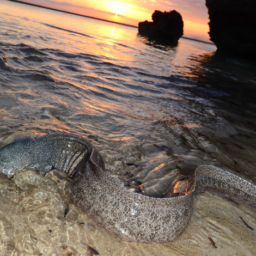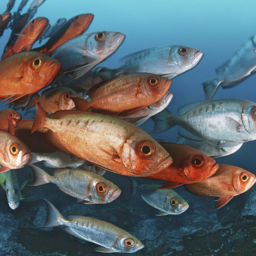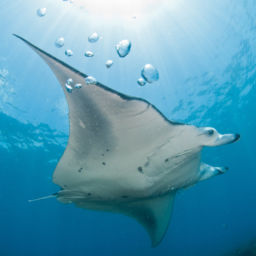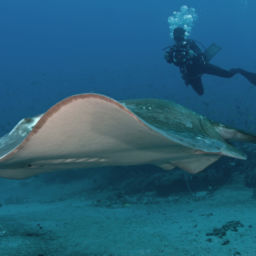The East African nation of Mozambique features almost 1,500 miles (2,300 km) of coastline along the Indian Ocean. And, thanks to all this oceanfront real estate, there’s amazing diving along the entire coast. We’ve covered the diving in southern Mozambique here and here. Now, we’ll highlight some of the best scuba diving in northern Mozambique. The waters here have not seen as much over-fishing as other areas in the world, which means that the reefs are teeming with both micro and macro marine life.
Getting to and around in Mozambique
Getting around in Mozambique is a bit more difficult compared to well-traveled destinations, so you must plan ahead. While inexpensive local chapas, a form of local transportation that could range from a minivan to an open-bed truck, and buses travel along the coast daily, they are not always the most reliable or safest forms of transport. Tourist buses and shuttles are better options. It’s best to travel only during daylight hours and to avoid Mozambican roads between 6 p.m. and 6 a.m. Private taxis or self-driving rental cars are also options. Most of the EN1 highway spanning Mozambique north to south is tarred and in fair condition, although you’ll likely want a 4-wheel-drive vehicle.
If you self-drive, adhere to the speed limits as they are strictly enforced. The speed limit in Mozambique is 100km/h (62 mph) outside of towns with 80/60 km/h (50/37 mph) in towns. Speed limits are strictly monitored with fines readily given for transgressions, so drive carefully. Add several extra hours to your travel time, no matter the destination, as everything in Mozambique is very much on African time.
You can reach many dive destinations by flying to a nearby airport and then either taking a taxi or arranging for airport pickup from your hotel. As with the roads, flights and airports also work on African time so be prepared for your journey to take longer than you planned.
When to go
Rainy season falls between December and March and it can get quite humid during this period. From June to October the weather is pleasant, with June to August being the coolest months. Winter in Mozambique is still warm, with temperatures during the day ranging from around 80 to 86 F (27 to 30 C). Cyclone season is from February to May, although usually this time of the year has mostly calm weather and cyclones seldom affect the coast of Mozambique.
Note that Mozambique is a malarial area, so take precautions with anti-malaria medication, mosquito nets and bug spray.
With visibility up to 100 feet (30 m) and water temperatures averaging around 28 C (82 F), mixed in with white beaches and African hospitality, the scuba diving in northern Mozambique truly has so much to offer. Here are our picks for the can’t miss sites.
Nacala Bay
Where is it: Nacala sits on a bay, Baia de Fernao Veloso, in northern Mozambique. You can reach it via car or flight. If you travel thorough Mozambique via road, total driving time from Maputo to Nacala could take between 31 and 35 hours. Alternatively, you can fly to Nampula, about 110 miles (180 km) west of Nacala, where you can rent a car (preferably a 4×4) and make your way to Nacala. There are a number of flights weekly from both Johannesburg and Nairobi to Nampula. The drive from Nampula to Nacala will take between 2.5 and 4 hours.
What makes it special: Nacala Bay has dive sites for both novices and more experienced divers. There are abundant coral gardens, some walls and a few swim-throughs. The marine life is diverse, with lots of nudibranchs, leaf fish, ribbon eels, frogfish and ghost pipefish. Advanced divers can dive at Stables, which features strong currents and lots of seahorses. Spectacular night dives are possible from the beach.
Details: There are a few dive centers and lodges in the area catering to a variety of tastes and budgets. Dive sites vary quite a bit in depth, which makes Nacala a great destination for divers of every experience level. Sites range from 60 to 130 feet (18 m to 40 m). Although the water temperature ranges from 75 F (24 C) from July to September to 86 F (30 C) from January to April, with an onshore breeze there might be tiny jellyfish in the water, so a full wetsuit is best.
When to go: February and August are the windier months, which lowers visibility. The best time to visit is between May and September.
Pemba
Where is it: Pemba is located 260 miles (420 km) north of Nacala via car. If you have time, this makes for a great addition to your road trip through Mozambique. Driving time between Nacala and Pemba is around 5 to 7 hours. Driving time from Maputo to Pemba is around 34 to 37 hours. If road-tripping isn’t your thing, there are flights from Johannesburg to Pemba twice a week. Flights between Maputo and Pemba are once a week, subject to change monthly. You can also reach Pemba by flying in from Dar es Salaam, Tanzania.
What makes it special: Pemba — not to be confused with Pemba in Zanzibar — has untouched coral, diverse marine life and beautiful beaches. The continental shelf drop-off starts at around 50 feet (15 m) and goes down to 400 feet (120 m). Because many dive sites here are around 100 feet (30 m), it is the perfect playground for advanced divers. Marine life around Pemba includes reef fish, a variety of corals, sharks, rays and even black marlin. On a dive close to the mouth of the Tari River you could see napoleon wrasse, reef sharks and snowflake soapfish. Diving the shelf in Pemba could mean spotting some mobula rays or even a mola mola as well.
Details: Accommodation ranges from five-star hotels to modest resorts and self-catering units. Pemba is becoming one of the best places for diving in Mozambique with a number of dive operators to choose from. Water temperatures range from 75 F (24 C) between July and September to 86 F (30 C) between January and April.
When to go: February and August are the windier months, which lowers visibility. The best time to visit is between May and September.
Quirimbas Archipelago
Where is it: The Quirimbas Archipelago sits 37 miles (60 km) north of Pemba as the crow flies. Most accommodations can assist you with transport from Pemba to the Quirimbas islands. There are some direct flights from Dar es Salaam to the islands.
What makes it special: With 27 islands in the largest marine protected area on the African continent, the Quirimbas Archipelago offers amazing diving. The area is still very much unexplored and thus the coral and marine life is pristine. Between Pemba and Tanzania, this area is truly off the beaten track and has much to offer the adventurous diver. There is an abundance of game fish, manta rays, whale sharks and at least eight species of shark in the area. You might also see pods of dolphins, schools of barracuda and kingfish and migrating humpback whales. Five of the ocean’s seven turtle species live in the Quirimbas Archipelago. You might get a chance to see some of them lay eggs on the beach in season, usually the last few months of the year leading into March as the peak nesting season. Check with your dive operator for peak nesting times.
Details: With dive sites ranging from 46 to 60 feet (14 to 80 m), the Quirimbas Archipelago has something for everyone. There are several dive operators, hotels and lodges on many of the islands, allowing you to tailor an ideal dive holiday. Water temperatures range from 75 to 86 F (24 to 30 C), so speak to your dive operator about the best exposure protection for your visit.
When to go: During the winter (June to August) the weather is drier with mild temperatures. There are low winds along with more marine-animal sightings. The average winter air temperatures range from 59 to 79 F (15 C to 26 C). Rainy season is between mid-November and April.








